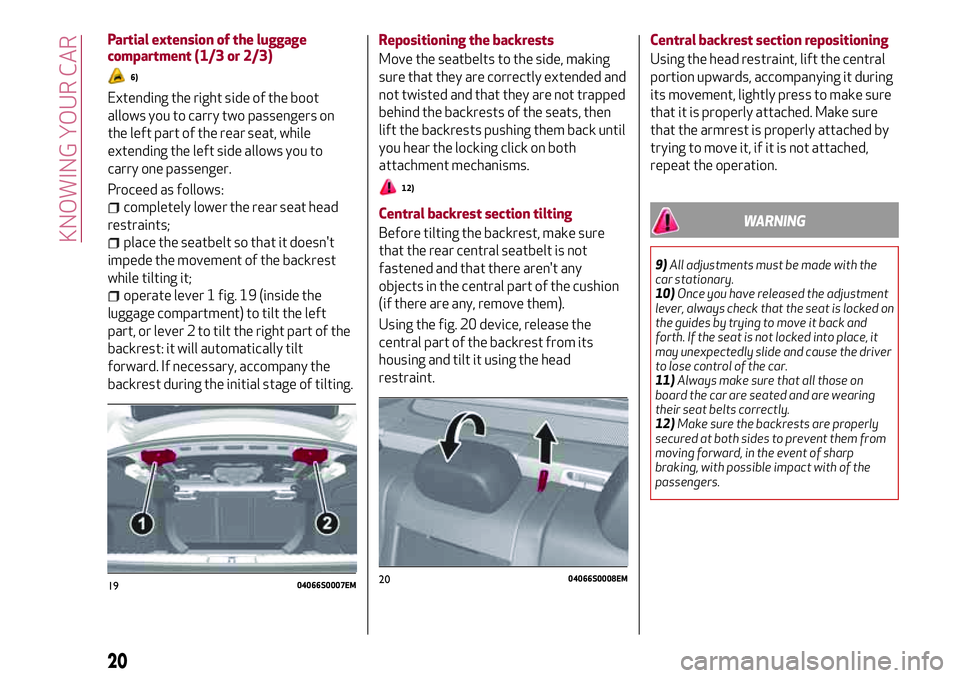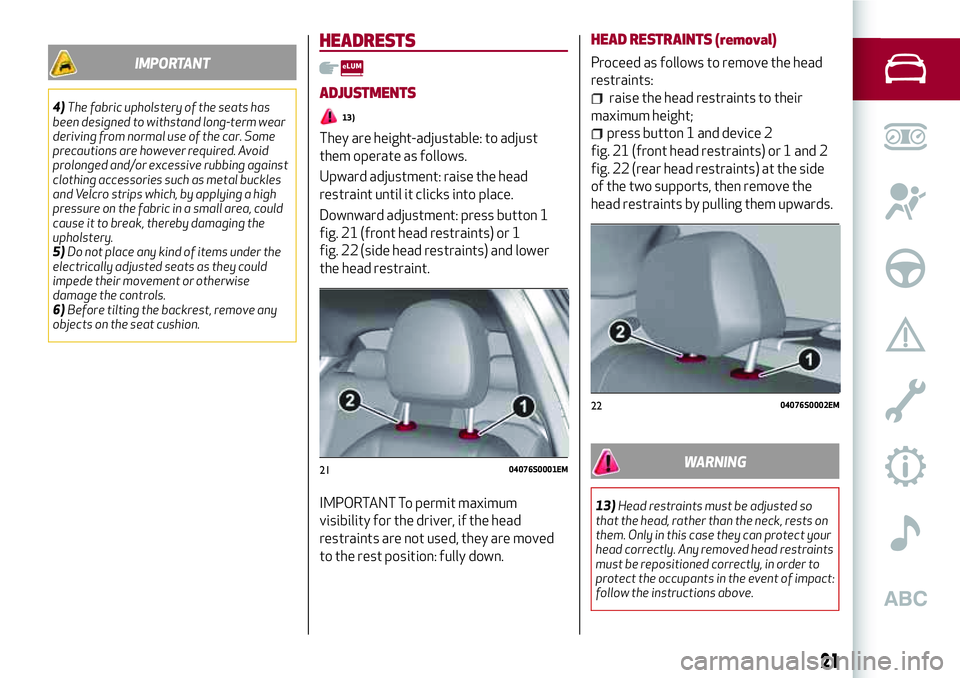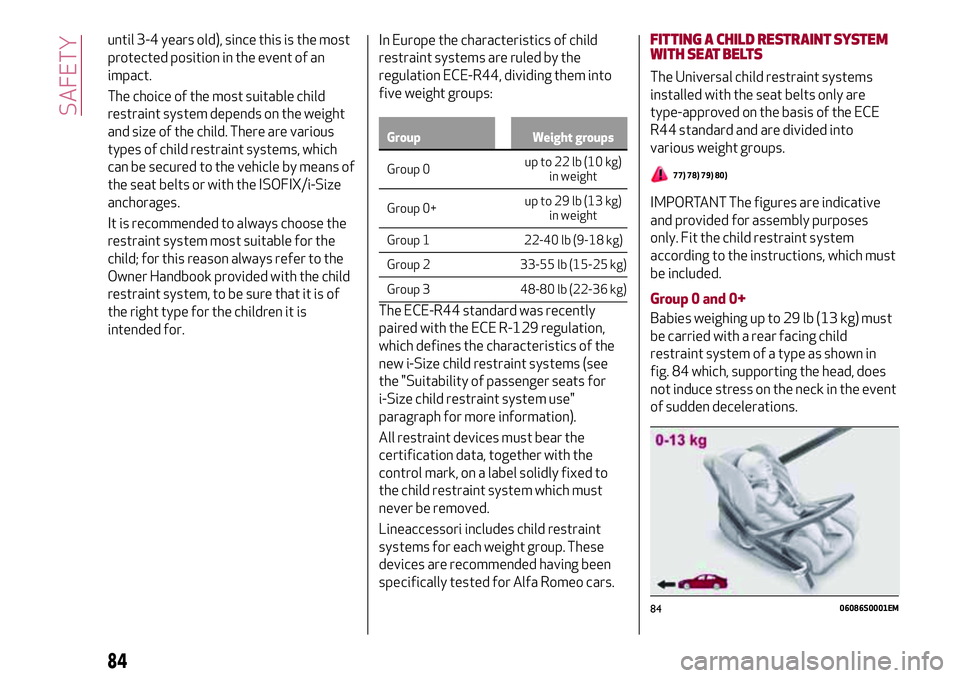remove seats Alfa Romeo Giulia 2016 Owner's Manual
[x] Cancel search | Manufacturer: ALFA ROMEO, Model Year: 2016, Model line: Giulia, Model: Alfa Romeo Giulia 2016Pages: 204, PDF Size: 4.95 MB
Page 22 of 204

Partial extension of the luggage
compartment (1/3 or 2/3)
6)
Extending the right side of the boot
allows you to carry two passengers on
the left part of the rear seat, while
extending the left side allows you to
carry one passenger.
Proceed as follows:
completely lower the rear seat head
restraints;
place the seatbelt so that it doesn't
impede the movement of the backrest
while tilting it;
operate lever 1 fig. 19 (inside the
luggage compartment) to tilt the left
part, or lever 2 to tilt the right part of the
backrest: it will automatically tilt
forward. If necessary, accompany the
backrest during the initial stage of tilting.Repositioning the backrests
Move the seatbelts to the side, making
sure that they are correctly extended and
not twisted and that they are not trapped
behind the backrests of the seats, then
lift the backrests pushing them back until
you hear the locking click on both
attachment mechanisms.
12)
Central backrest section tilting
Before tilting the backrest, make sure
that the rear central seatbelt is not
fastened and that there aren't any
objects in the central part of the cushion
(if there are any, remove them).
Using the fig. 20 device, release the
central part of the backrest from its
housing and tilt it using the head
restraint.Central backrest section repositioning
Using the head restraint, lift the central
portion upwards, accompanying it during
its movement, lightly press to make sure
that it is properly attached. Make sure
that the armrest is properly attached by
trying to move it, if it is not attached,
repeat the operation.WARNING
9)All adjustments must be made with the
car stationary.
10)Once you have released the adjustment
lever, always check that the seat is locked on
the guides by trying to move it back and
forth. If the seat is not locked into place, it
may unexpectedly slide and cause the driver
to lose control of the car.
11)Always make sure that all those on
board the car are seated and are wearing
their seat belts correctly.
12)Make sure the backrests are properly
secured at both sides to prevent them from
moving forward, in the event of sharp
braking, with possible impact with of the
passengers.
1904066S0007EM2004066S0008EM
20
KNOWING YOUR CAR
Page 23 of 204

IMPORTANT
4)The fabric upholstery of the seats has
been designed to withstand long-term wear
deriving from normal use of the car. Some
precautions are however required. Avoid
prolonged and/or excessive rubbing against
clothing accessories such as metal buckles
and Velcro strips which, by applying a high
pressure on the fabric in a small area, could
cause it to break, thereby damaging the
upholstery.
5)Do not place any kind of items under the
electrically adjusted seats as they could
impede their movement or otherwise
damage the controls.
6)Before tilting the backrest, remove any
objects on the seat cushion.
HEADRESTS
ADJUSTMENTS
13)
They are height-adjustable: to adjust
them operate as follows.
Upward adjustment: raise the head
restraint until it clicks into place.
Downward adjustment: press button 1
fig. 21 (front head restraints) or 1
fig. 22 (side head restraints) and lower
the head restraint.
IMPORTANT To permit maximum
visibility for the driver, if the head
restraints are not used, they are moved
to the rest position: fully down.HEAD RESTRAINTS (removal)
Proceed as follows to remove the head
restraints:
raise the head restraints to their
maximum height;
press button 1 and device 2
fig. 21 (front head restraints) or 1 and 2
fig. 22 (rear head restraints) at the side
of the two supports, then remove the
head restraints by pulling them upwards.
WARNING
13)Head restraints must be adjusted so
that the head, rather than the neck, rests on
them. Only in this case they can protect your
head correctly. Any removed head restraints
must be repositioned correctly, in order to
protect the occupants in the event of impact:
follow the instructions above.
2104076S0001EM
2204076S0002EM
21
Page 86 of 204

until 3-4 years old), since this is the most
protected position in the event of an
impact.
The choice of the most suitable child
restraint system depends on the weight
and size of the child. There are various
types of child restraint systems, which
can be secured to the vehicle by means of
the seat belts or with the ISOFIX/i-Size
anchorages.
It is recommended to always choose the
restraint system most suitable for the
child; for this reason always refer to the
Owner Handbook provided with the child
restraint system, to be sure that it is of
the right type for the children it is
intended for.In Europe the characteristics of child
restraint systems are ruled by the
regulation ECE-R44, dividing them into
five weight groups:
Group Weight groups
Group 0up to 22lb (10 kg)
in weight
Group 0+up to 29 lb (13 kg)
in weight
Group 1 22-40 lb (9-18 kg)
Group 2 33-55 lb (15-25 kg)
Group 3 48-80 lb (22-36 kg)
The ECE-R44 standard was recently
paired with the ECE R-129 regulation,
which defines the characteristics of the
new i-Size child restraint systems (see
the "Suitability of passenger seats for
i-Size child restraint system use"
paragraph for more information).
All restraint devices must bear the
certification data, together with the
control mark, on a label solidly fixed to
the child restraint system which must
never be removed.
Lineaccessori includes child restraint
systems for each weight group. These
devices are recommended having been
specifically tested for Alfa Romeo cars.
FITTING A CHILD RESTRAINTSYSTEM
WITH SEAT BELTS
The Universal child restraint systems
installed with the seat belts only are
type-approved on the basis of the ECE
R44 standard and are divided into
various weight groups.
77) 78) 79) 80)
IMPORTANT The figures are indicative
and provided for assembly purposes
only. Fit the child restraint system
according to the instructions, which must
be included.
Group 0 and 0+
Babies weighing up to 29 lb (13 kg) must
be carried with a rear facing child
restraint system of a type as shown in
fig. 84 which, supporting the head, does
not induce stress on the neck in the event
of sudden decelerations.
8406086S0001EM
84
SAFETY